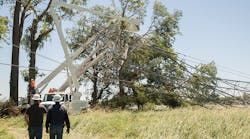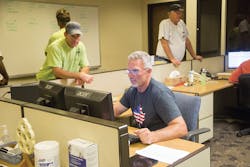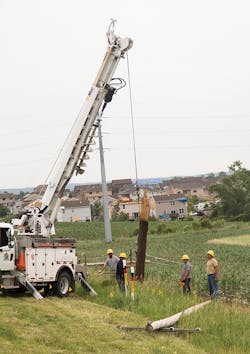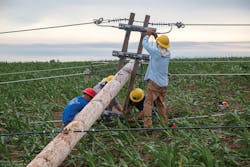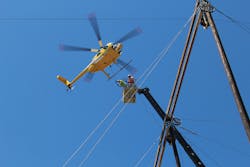Two tornadoes spiraled just outside Omaha, Nebraska, twisting transmission towers, uprooting trees and ripping off roofs from homes. At the peak of the storm, 76,500, or 20%, of OPPD’s customers were without power.
Straight-line winds of 81 mph and the tornadoes caused 57 transmission and 12 distribution lockouts in Bellevue and Papillion. Because of the magnitude and widespread nature of the severe weather event, Omaha Public Power District (OPPD) declared the storm a Level 2 and the fourth worst to hit its service territory.
The EF1 and EF2 tornadoes touched down in the southern part of the Omaha metro area. As a result, trees were snapped in two, power poles fell like dominoes and the area sustained millions of dollars in damage. Ryan Mayberry, manager of OPPD’s Elkhorn Center and storm manager, says the recent storm was particularly destructive.
“Typical summer storms damage mostly power poles and lines that transport electricity from substations to customers,” Mayberry said. “But this storm also damaged high-voltage structures and lines that transport electricity from the power plant to the substations.”
Seven miles of transmission lines were in the path of the tornado, which blew down lines and structures. In addition, the tornado-force winds yanked a transmission tower out of its foundation and hurled it several feet away. The tornado-force winds also uprooted cottonwood trees, some measuring up to 12 ft in diameter, between Offutt Air Force Base and the Missouri River.
Ramping Up for the Storm
Within hours of the storm, OPPD’s storm team sprang into action by lining up resources, mobilizing crews and preparing materials. As soon as the severe weather forecasts started rolling in, the storm manager notified the storm team members that a storm was imminent and that they should be prepared for the emergency situation.
The storm manager begins activating the storm team according to a checklist. First, he calls the construction manager who notifies the duty supervisor, who then calls the linemen and other field crews. Because of the severity of this particular storm, many were already on the property and ready to work before they even received a call.
During an emergency, all the members on the storm team have a specific role in assessing damage, and organizing and executing restoration and rebuilding efforts. The storm team includes companywide representation including employees from damage assessment; corporate marketing and communications; call center support; logistics; safety; transmission and distribution; IT; transportation; governmental support; accounting, and forestry.
To ensure storm response goes smoothly, all members of the storm team have backups. For example, since some of the storm team members were on vacation when the storm hit, they prepared their backup before they left the office. Because of the dedication of the OPPD field and office workers, however, even some employees who were out of the office returned to Omaha to help restore power and fulfill their duties as part of the storm team. For example, Mayberry, who was out of town on vacation, returned to Omaha and resumed as the storm team manager the day after the storm blew into southeast Nebraska.
Another way OPPD ensures that it is ready to handle anything Mother Nature throws its way is by conducting regular storm drills. Ironically, the utility drilled the exact same storm scenario two years ago. During that drill, a tornado and high winds hit during the College World Series, which is precisely what happened this summer.
This year, the storm hit on opening night of the College World Series, when a lot of visitors were in town and staying at the local hotels. As such, the NCAA postponed its opening ceremonies.
Lending a Helping Hand
As a member of the Public Power Mutual Aid Network, OPPD has sent crews to New York City, Louisiana and Mississippi. Following the recent storm, crews from Nebraska, Iowa, Colorado and Alabama traveled to Omaha to help restore power.
At 8 p.m. on a Friday night, OPPD’s external resource coordinator reached out to the neighboring utilities, like Nebraska Public Power District (NPPD), Kansas City Power and Light, and Lincoln Electric, which were all affected by the storm as well. The very next day, however, NPPD, Lincoln Electric and MidAmerican Energy as well as several other contractors offered a helping hand.
Once OPPD’s external resource coordinators confirmed which companies were offering mutual aid, the safety department then offered safety briefings to the line crews as soon as they arrived on property. In addition to explaining the magnitude of the situation and the safety rules that the linemen needed to follow, OPPD assigned an external crew coordinator (a bird dog) to each external crew. This individual, who either works full-time for OPPD or has retired from the utility, works with the dispatcher, holds the proper clearances and ensures that the mutual aid crews have the right materials. In addition, the bird dog confirms that the crews are restoring power and rebuilding infrastructure correctly and following the rules and procedures set forth by OPPD.
Meanwhile, the logistics team ensures that the staging areas are set up for the external crews. Because so many College World Series fans were in Omaha the weekend of the storm, the logistics coordinator had to go outside the metro area to find lodging for the 200 extra linemen who had come to Omaha to help restore power.
Restoring Power
Following a severe weather event, OPPD’s dispatchers and energy control centers assign the troubleshooters and line crews to patrol the circuits. The field workers then focus on restoring power to top-priority circuits, hospitals and other critical customers. During this storm, however, several circuits were locked out simultaneously and the transmission system endured a significant amount of damage.
To improve the productivity of the troubleshooters following storms and everyday power outages, OPPD equipped the workers’ vehicles with mobile computers. Other work groups such as meter technicians and street-light workers also use the mobile computers on a daily basis and as they work storm restoration as downed wires crews. As a result, OPPD has lessened radio traffic and eliminated the need for dispatchers to phone in work orders to a portion of the field workforce. Also, the troubleshooters can access the outage management system from the field, giving them up-to-date information during the storm response.
Along with the troubleshooters and linemen, the external resource coordinators also played a pivotal role in the rapid restoration of power. Since they knew from the beginning that the storm was going to be of a large magnitude, OPPD tried to get as many transmission crews on property as possible to help with the cleanup, make the necessary repairs and restore power.
The storm hit on Friday, June 16, and the crews worked through Saturday night until 10 p.m., when they were released to go home and get some rest. They then reported back on the job at 6 a.m. on Sunday morning and worked 16-hour shifts until the storm restoration was completed.
To ensure continual coverage, OPPD kept about 15 linemen on the property to work the overnight shift. That way, the utility could keep the restoration efforts going, work around the clock, and address any emergencies that came up. While working in the hot and humid weather, the linemen focused on staying hydrated and getting sufficient rest, and as a result, there were no accidents or illnesses during the storm response.
Working from the Air
The storm damaged dozens of high-voltage transmission structures, including one along the Platte River. With wires down in the water, the linemen first focused on grounding the lines and removing them from the river. Next, the crews built a support structure to hold up the lines, and during the pulling process, they had to coordinate the timing with boat and train crossings.
Because they had to restring the transmission line across the river, the linemen joined forces with a helicopter pilot to get the job done as quickly as possible. First, the transmission crews connected a hardline to the helicopter to pull it across the river. After given the all-clear signal, the helicopter then flew the line to the other side of the Platte River, where it was handed off to a line crew on the other side. The linemen then used the hardline to pull the transmission conductor across the river and reconnect the line.
In addition to using a helicopter for restoration, the linemen also relied on trucks and heavy machinery on the ground. After the storm, the crews focused on restoring power to as many areas as possible, but some were so damaged that the repairs will need to be done gradually. For example, in one part of the city, 3 miles of three-phase lines were down on the ground and had to be completely rebuilt. Also, the street-lighting crews will need to restring lines and wires after the homes in the affected neighborhoods have been repaired and reconstructed.
Within the first 24-hour period, however, the linemen were able to restore 70% of the outages because of the dedication of the internal and external field workforce and their commitment to a safe and rapid response to the destructive storm. ♦
Cheryl Limbach is the manager of distribution services for OPPD. In this position, she manages troubleshooters, underground house services, equipment operators, streetlight workers and meter technicians. When a storm hits, she manages of the construction management team and works with the field crews.
Editor’s note: Visit tdworld.com to see a photo gallery of the damage caused by the storm as well as the restoration. To view OPPD’s video, which has received 65,000 views on Facebook, visit oppdthewire.com/bellevue-tornado-storm-restoration-recap.
Check out the September 2017 issue for more articles, news and commentary.
